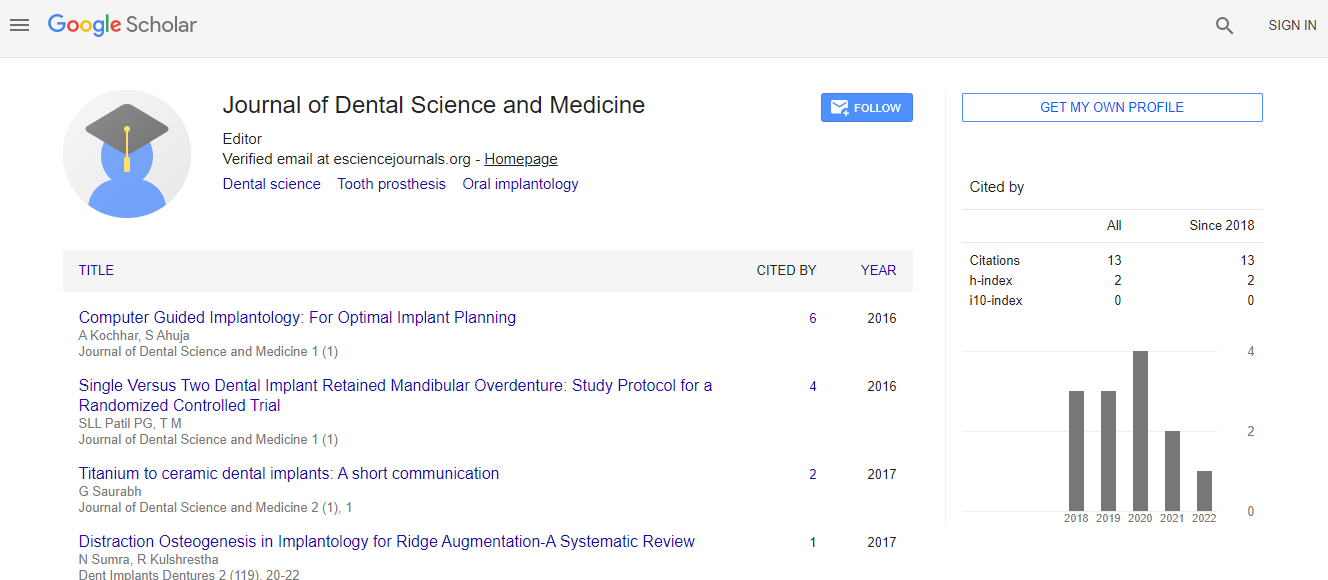Our Group organises 3000+ Global Conferenceseries Events every year across USA, Europe & Asia with support from 1000 more scientific Societies and Publishes 700+ Open Access Journals which contains over 50000 eminent personalities, reputed scientists as editorial board members.
Open Access Journals gaining more Readers and Citations
700 Journals and 15,000,000 Readers Each Journal is getting 25,000+ Readers
Google Scholar citation report
Citations : 13
Journal of Dental Science and Medicine received 13 citations as per Google Scholar report
Indexed In
- RefSeek
- Hamdard University
- EBSCO A-Z
- ICMJE
Useful Links
Recommended Journals
Related Subjects
Share This Page
Microtensile bond strength and micromorphologic analysis of surface-treated resin nanoceramics
29th Annual World Congress on Dental Medicine & Dentistry
Gyo-Zin Ahn, Joon-Ho Park, Mi-Joo Oh and Yu-Sung Choi
Dankook University, Republic of Korea
Posters & Accepted Abstracts: Dent Implants Dentures
Abstract
Purpose: The aim of this study was to evaluate the influence of different surface treatment methods on the microtensile bond strength of resin cement to resin nanoceramic (RNC). Materials & Methods: RNC onlays (Lava Ultimate) (n=30) were treated using air abrasion with and without a universal adhesive, or HF etching followed by a universal adhesive with and without a silane coupling agent, or tribological silica coating with and without a universal adhesive, and divided into 6 groups. Onlays were luted with resin cement to dentin surfaces. A microtensile bond strength test was performed and evaluated by one-way ANOVA and Turkey HSD test (a=.05). A nanoscratch test, field emission scanning electron microscopy, and energy dispersive X-ray spectroscopy were used for micromorphologic analysis (a=.05). The roughness and elemental proportion were evaluated by Kruskal-Wallis test and Mann-Whitney U test. Resluts: Tribologigcal silica coating showed the highest roughness, followed by air abrasion and HF etching. After HF etching, the RNC surface presented a decrease in oxygen, silicon, and zirconium ratio with incraeasing carbon ratio. Air abrasion with universal adhesive showed the highest bond strength followed by tribologigcal silica coating with universal adhesive. HF etching with universal adhesive showed the lowest bond strength. Conclusion: An improved understanding of the effect of surface treatment of RNC could enhance the durability of resin bonding, when used for indirect restorations. When using RNC for restoration, effective and systemic surface roughening methods and an appropriate adhesive are required.Biography
Gyo-Zin Ahn has completed his Bachelor’s Degree from College of Dentistry Dankook University. Currently, he is pursuing his Master’s course in Dental Prosthodontics.

 Spanish
Spanish  Chinese
Chinese  Russian
Russian  German
German  French
French  Japanese
Japanese  Portuguese
Portuguese  Hindi
Hindi 